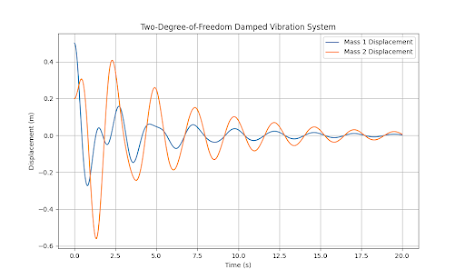Hey everyone, welcome back to my blog. This time I am going to tour you through the two degree of freedom free damped vibration system with python implementation. So, lets deep dive into this article.
So, let me ask you a question,
What is
2-DOF damped vibration system?
Any guesses???
Nope?? Then, let's check what could be the answer....
A two-degree-of-freedom (2-DOF) free damped vibration system is formed from two masses with two spring and two dampers connected to it. For formulating equations of motion, it involves both the masses. The general representation of a 2-DOF free damped vibration system is as follows,
Consider,
- m1 and m2 are the masses of first and second body (mass) respectively.
- c1 and c2 are the damping coefficients of the dampers connected to first and second body (mass) respectively.
- k1 and k2 are the stiffness coefficients of the springs connected to first and second body (mass) respectively.
- x1(t) and x2(t) are the displacements of first and second body (mass) respectively as a function of time, t.
- v1 and v2 are the velocities of first and second body (mass) respectively as a function of time, t.
- a1 and a2 are the accelerations of first and second body (mass) respectively as a function of time, t.
Differential Equations
are very much helpful for modelling complex dynamic systems which are time
dependent. So, we are going to use this incredible mathematical concept to
model our 2-DOF freedom system as follows,
The equations can be
written as system of second-order ordinary differential equations (ODEs).
For the first mass (m1),
For the second mass (m2),
Solving the above equations for given initial conditions, which are, x1(0), x2(0), v1(0), v2(0) and parameters m1, m2, k1, k2, c1 and c2 will give us time dependent displacements x1(t) and x2(t), and velocities v1(t) and v2(t) of both masses.
Now, it’s time for some
python stuff, so prepare your fingers to hit some buttons!!
# Importing necessary
libraries
import numpy as np
from scipy.integrate
import odeint
import
matplotlib.pyplot as plt
# Defining the system
variables
mass1 = 3.0 # Mass of the first mass (kg)
mass2 = 1.0 # Mass of the second mass (kg)
stiffness1 = 30.0 #
Spring constant of the first spring (N/m)
stiffness2 = 10.0 # Spring constant of the second spring (N/m)
dampingCoeff1 = 1.5 # Damping
coefficient of the first damper (N*s/m)
# Initial conditions
displacement1_0 = 0.5 #
Initial displacement of mass 1 (m)
displacement 2_0 = 0.2 #
Initial displacement of mass 2 (m)
velo1_0 = 0.0 # Initial velocity of mass 1
(m/s)
# Defining function for Ordinary Differential Equations of the
# 2-DOF system
def TwoDOFsystem(state,
time):
displacement1, displacement2,
velo1, velo2 = state
dx1dt = velo1
dx2dt = velo2
dv1dt = (-(stiffness1 + stiffness2) * displacement1 -
(dampingCoeff1 + dampingCoeff2) * velo1 +
stiffness2 * (displacement2 - displacement1) +
dampingCoeff2 * (velo2 - velo1)) / mass1
dv2dt = (stiffness2 * (displacement1 - displacement2) +
dampingCoeff2 * (velo1 - velo2)) / mass2
return [dx1dt, dx2dt, dv1dt, dv2dt]
# Initialising the time
and creating time steps for simulation
time = np.linspace(0, 20,
2000)
# Initial state vector
initial_state = [displacement1_0,
displacement2_0, velo1_0, velo2_0]
# Solve the system of
ODEs
solution = odeint(TwoDOFsystem,
initial_state, time)
# Extract the
displacements of mass 1 and mass 2
displacement1 =
solution[:, 0]
displacement2 =
solution[:, 1]
# Plot the
displacements
plt.figure(figsize=(10,
6))
plt.plot(time, displacement1,
label='Mass 1 Displacement')
plt.plot(time, displacement2,
label='Mass 2 Displacement')
plt.xlabel('Time (s)')
plt.ylabel('Displacement
(m)')
plt.legend()
plt.grid(True)
plt.title('Two-Degree-of-Freedom
Damped Vibration System')
As you can see, the vibrations or displacement diminishes with time. This is because of presence of damper in the system, for each mass.
You can change the values and can play with system accordingly.
Thanks for your attention till the end. If you have any doubts or found some mistake please comment out. I will reach to you.
If you have any topic related to mechanical field, in mind which needs some python touch please tell me, I will blog it in future.
Thank you all. See you in next blog.






No comments:
Post a Comment